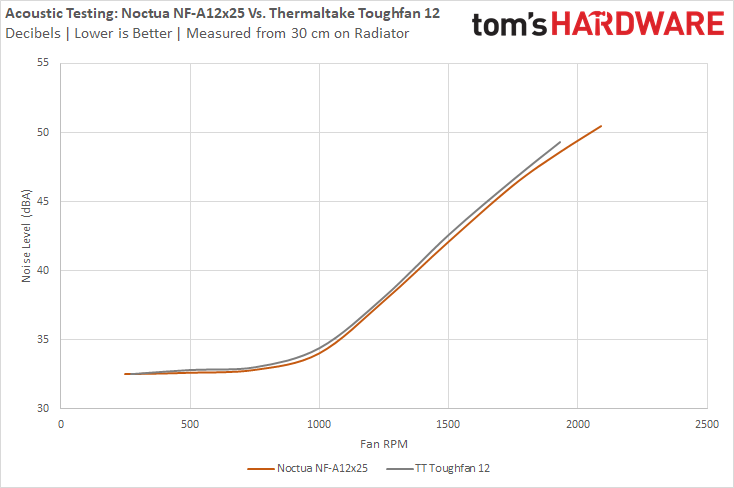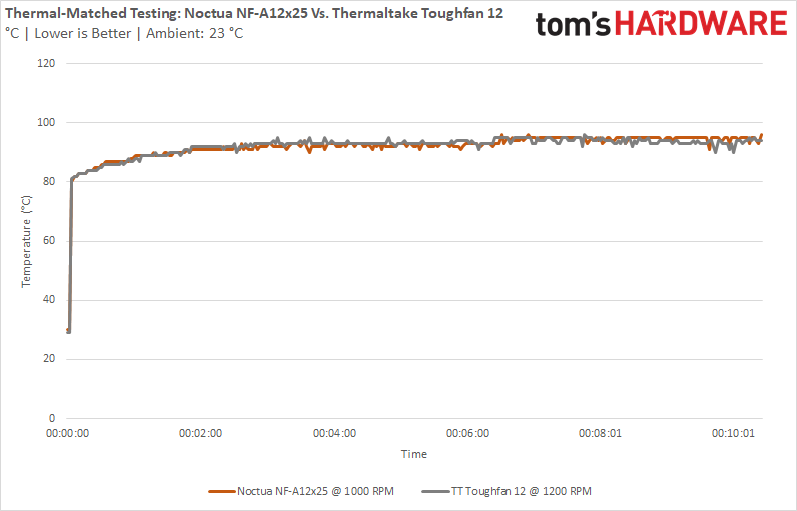PC Fan Faceoff: Noctua NF-A12x25 vs. Thermaltake ToughFan 12
When Noctua came out with the NF-A12x25 fan almost three years ago, it quickly went on its way to becoming arguably the world’s best PC fan. It performed great as an airflow fan, CPU cooler fan, and radiator fan. But bathed in the company’s iconic brown and beige, the one place it lost out to the competition was looks.
At least, that’s what the general consensus seems to be. And while I personally absolutely dig the Noctua’s colors as a classy option (especially with a few plants in the room), the vast majority of PC builders would rather see a more neutral color scheme. But what if you want the best PC fan along and great looks?
In comes the Thermaltake ToughFan 12. Dressed in a suit of black and grey, It’s the best alternative lookalike option to the brown and beige NF-A12x25, at least until Noctua finally comes out with the black variant, which is supposed to happen near the end of Q2 2021.
The Thermaltake ToughFan 12 came out near the end of last year, and at first sight, it appears to be a blatant copy of Noctua’s award-winning fan design. Both have nine forward-swept fan blades, a partially-exposed hub, similar noise performance ratings, an identical RPM range with PWM control, and included low-noise cables for reducing the fan’s maximum speed. But whereas the Noctua spinner is priced at $30 each, the ToughFan 12 comes in at $25 per fan or $40 for a two-pack, which is where things start to get interesting. Let’s dig a little deeper.
Inspection of Physical Differences
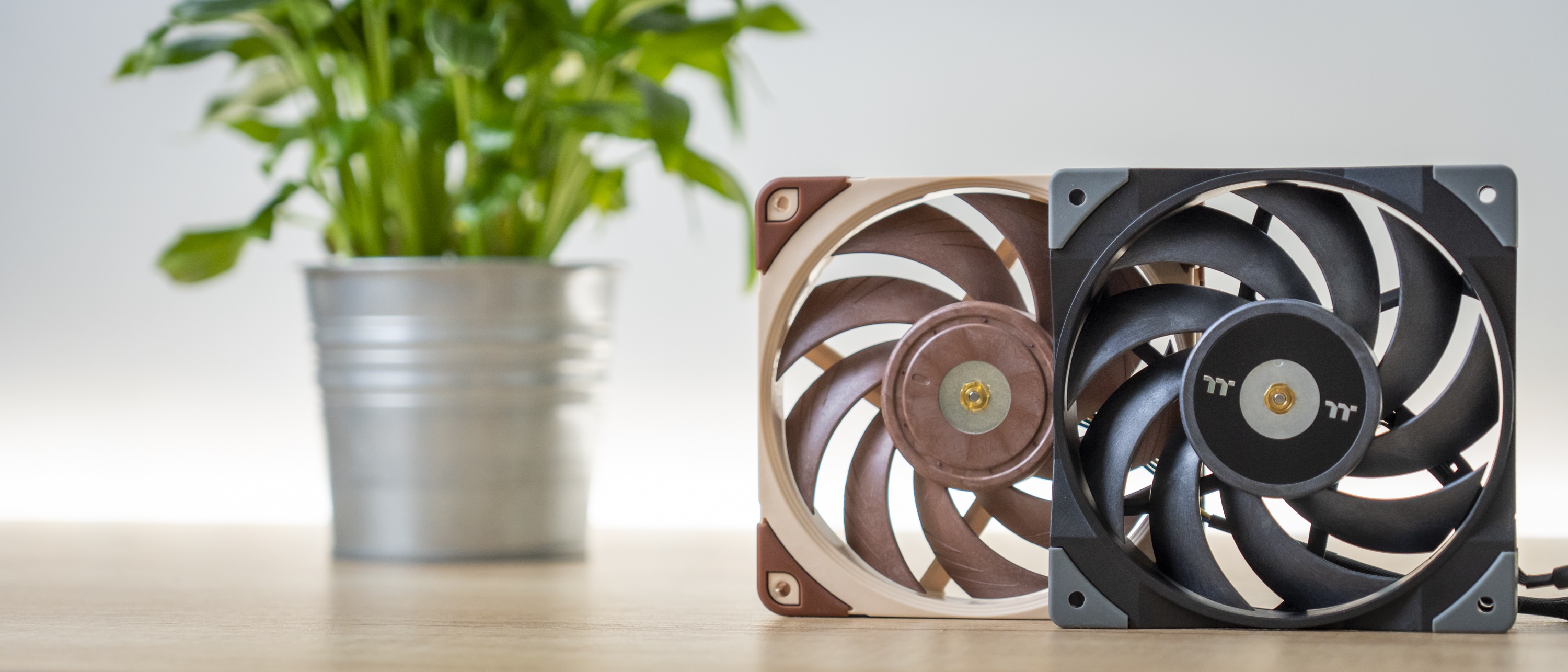
At first sight, these two fans look very similar--aside form the color scheme--with nearly identical designs. However, there are more differences than initially meet the eye, so lets go through them.
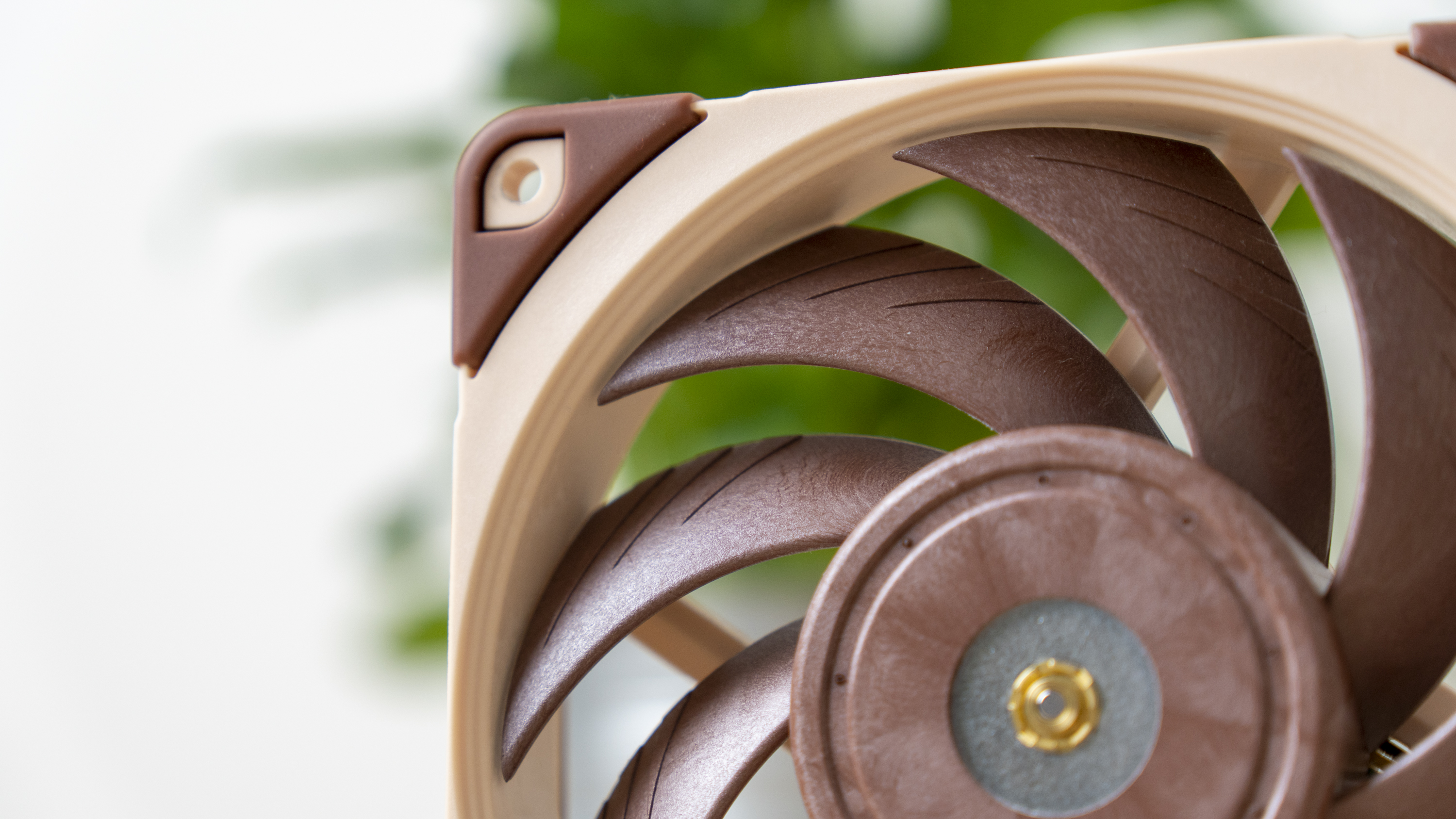

Starting off with the blades, you’ll spot that both appear to be made of a similar material. Noctua’s blades are made from Sterrox, a liquid-crystal polymer material that ensures it stays as rigid as possible. Apparently, fan blades can expand over time, and because Noctua wants the blades as close as possible to the frame, the material needs to be strong enough to withstand this expansion.
Thermaltake’s blades appear to be manufactured from a similar type of material, but I was unable to find a clear answer whether it’s the same.
Get Tom's Hardware's best news and in-depth reviews, straight to your inbox.
The blades on Noctua’s NF-A12x25’s also have flow acceleration channels that help speed up airflow and reduce side flow, which increases performance and reduces noise. The blades on the Thermaltake Toughfan 12’s are smooth.

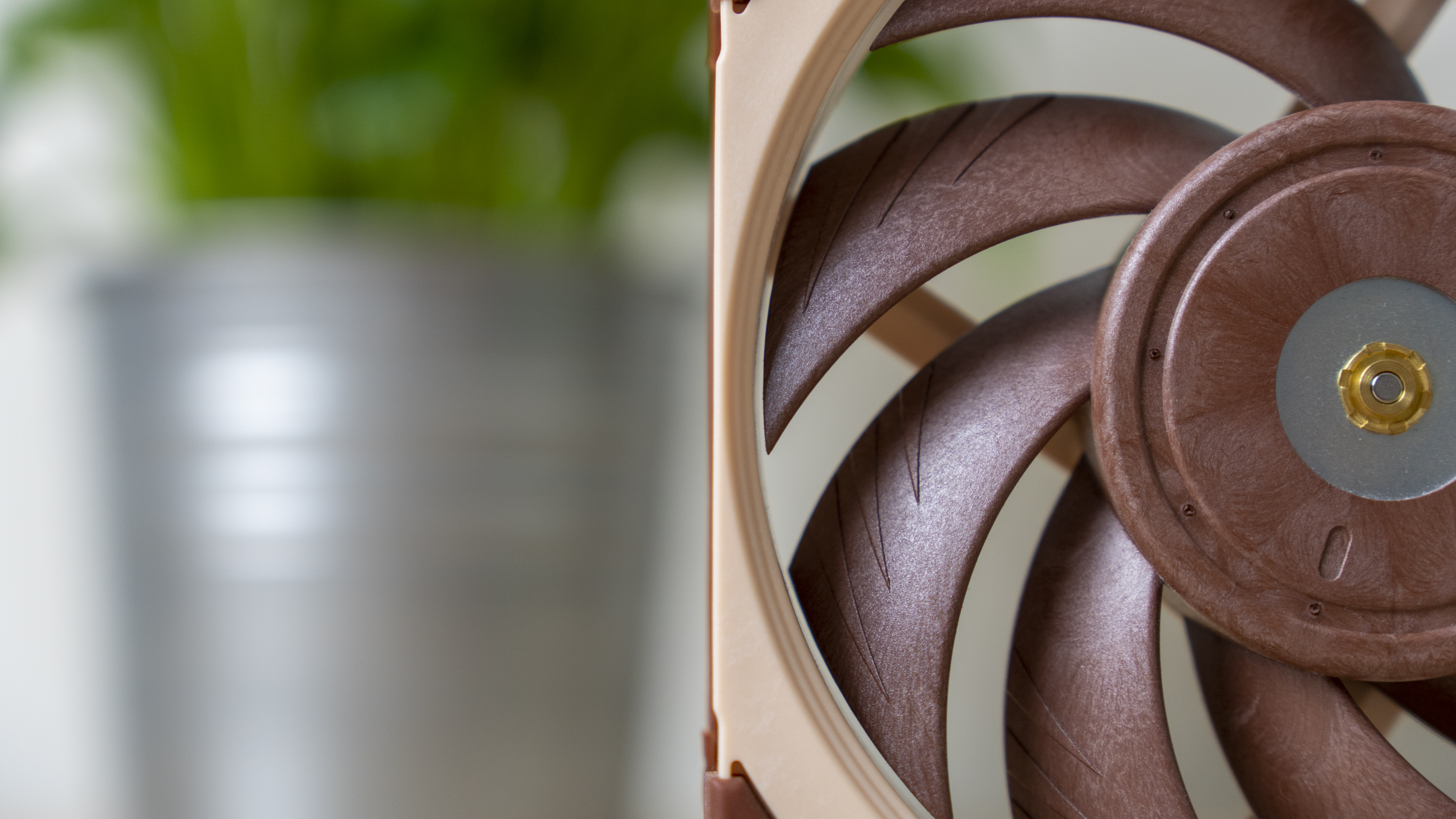
Having a look at the blade gap, you’ll spot that the blades from both fans are really close to the frame. Noctua has a slight advantage here, and the frame seems to be more consistently round, ensuring an equal blade-to-frame gap across the fan.
Also notice that Noctua’s frame has a ribbed guide for air inlet, whereas Thermaltake’s frame offers a simpler design.
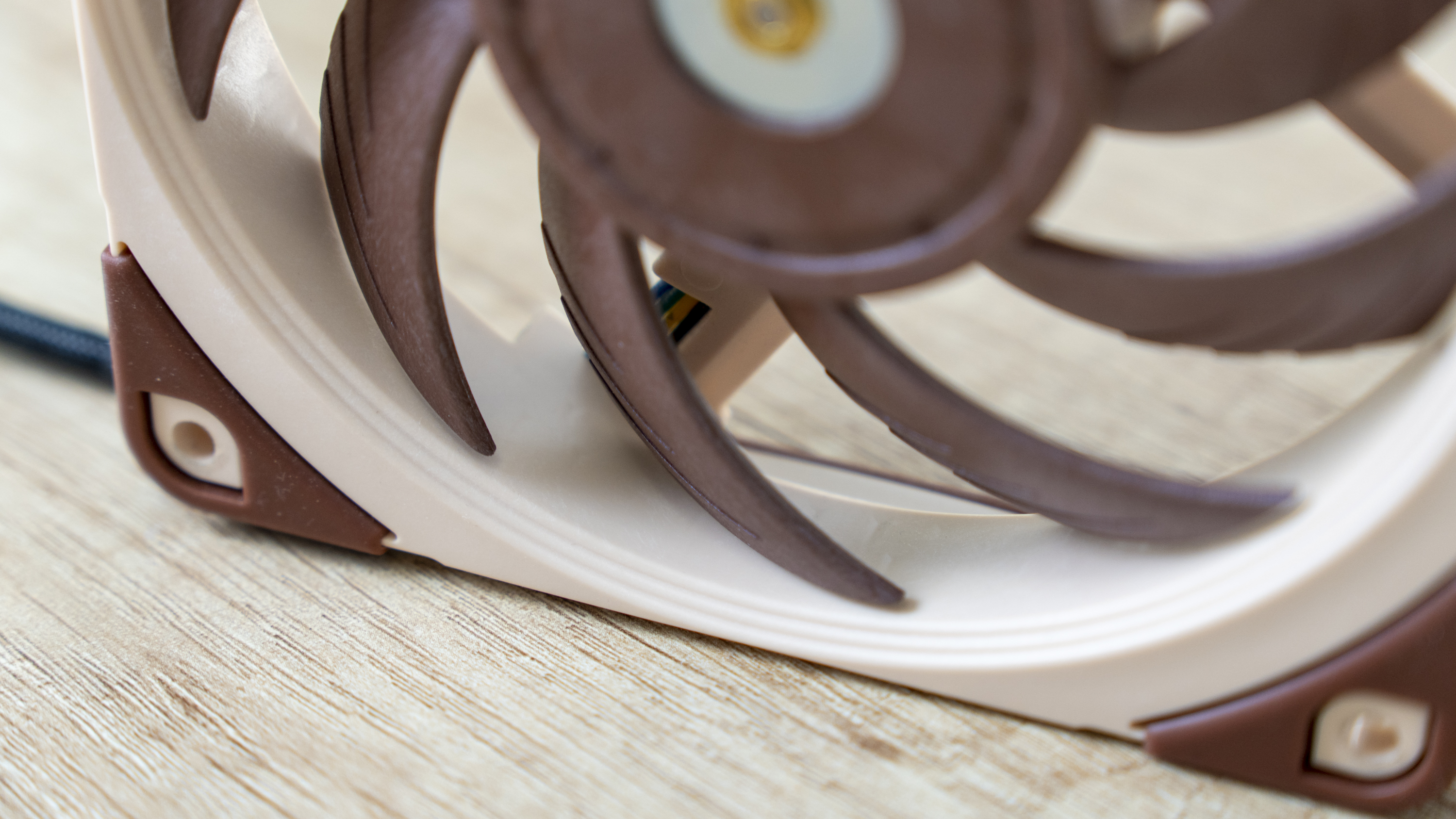
In fact, there’s more to Noctua’s frame than might be clear at first sight. If you look very closely at the inside of the frame, there are small dimples. These are Noctua’s “inner surface microstructures,” which help air ‘roll’ along the edge, reducing blade passing noise.
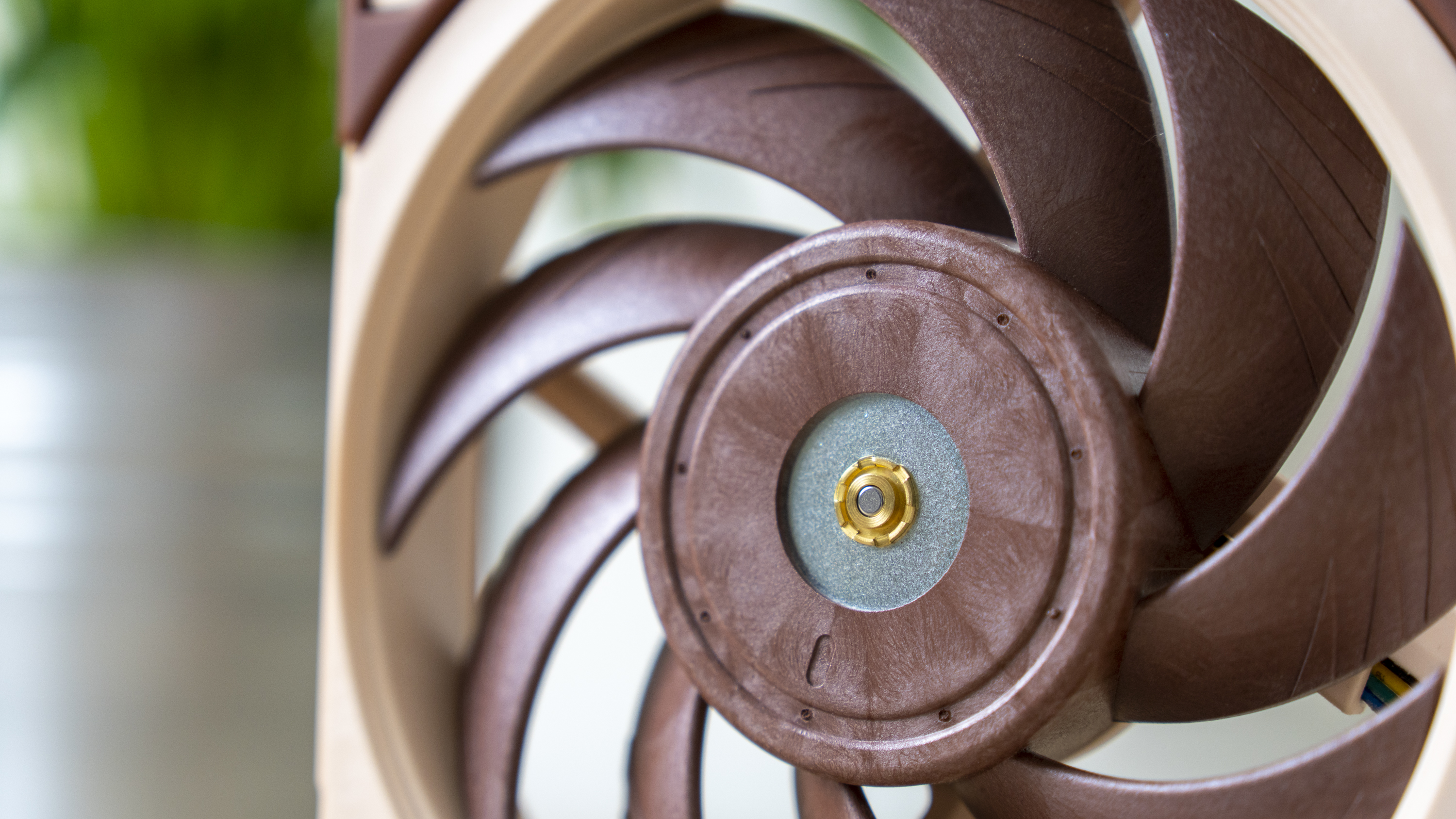
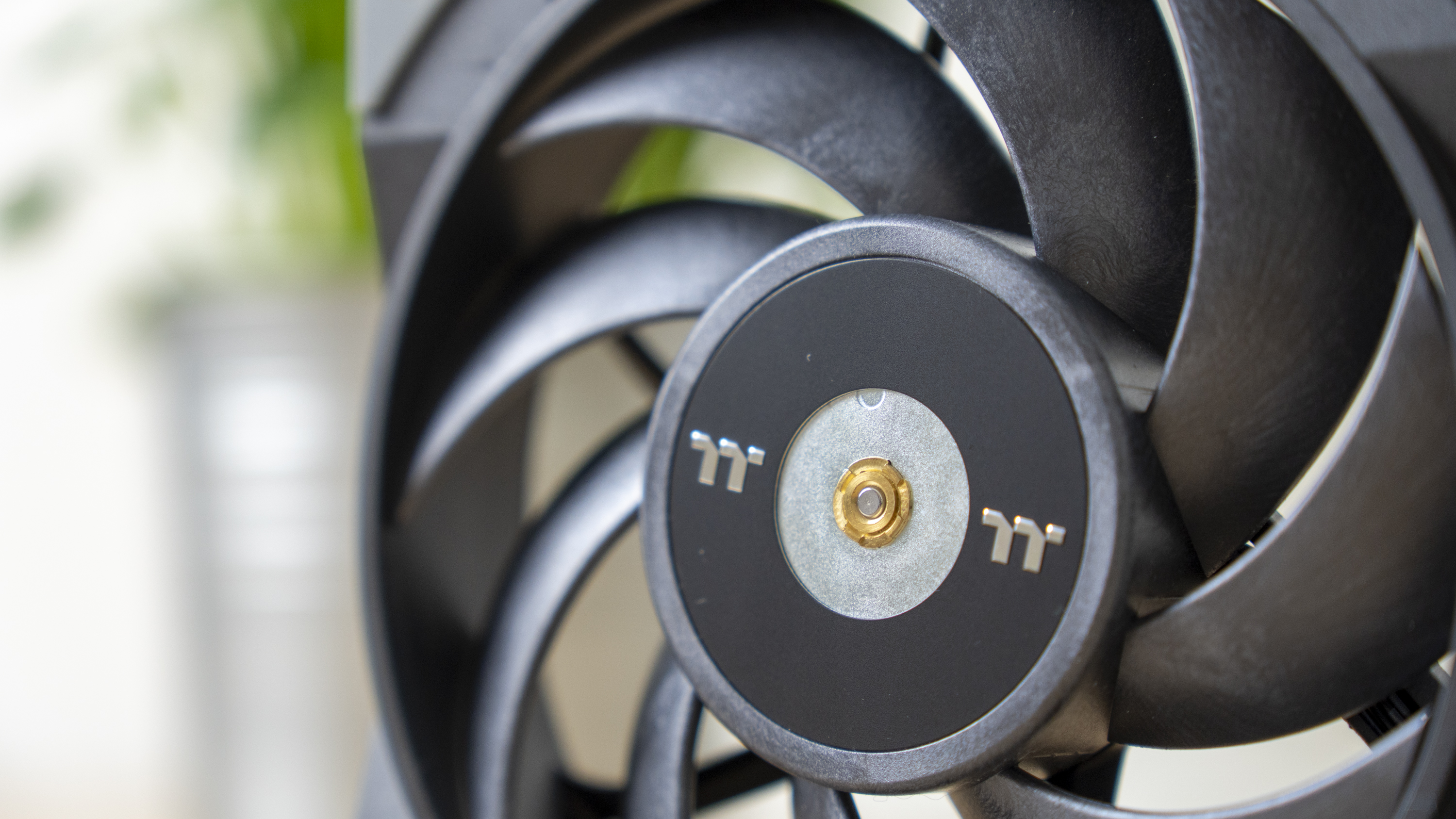
Looking at the fan hub of both spinners, they again seem to have similar designs at first. However, where Noctua’s blades transition into a large cover for the hub, Thermaltake uses a sticker to cover up the majority of the fan hub.
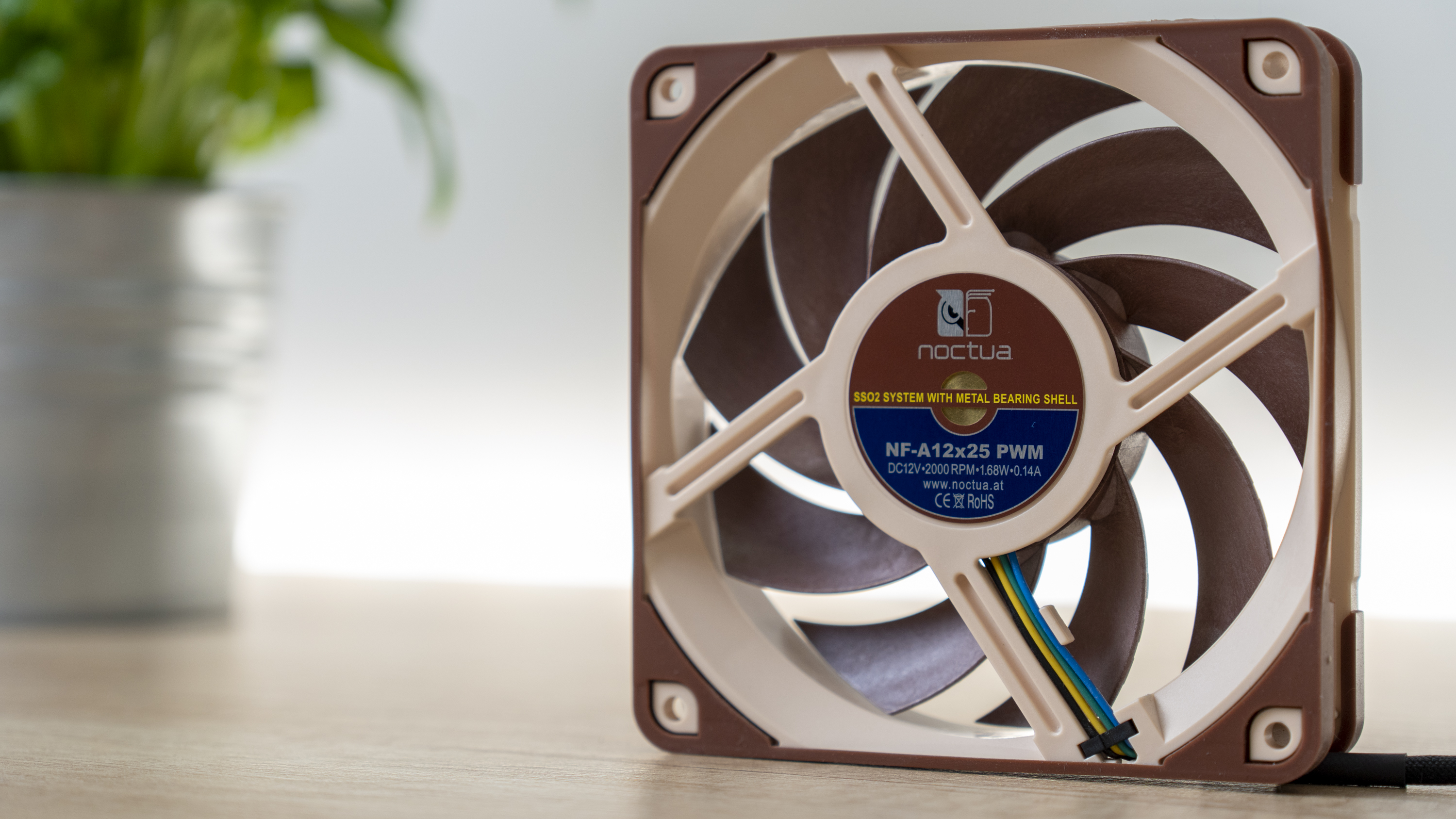

Turning to the back of the fans, there are clearer design differences in the frame. Noctua’s frame uses four legs to hold the fan motor, and the frame expands outward. There is also a rubber seal around the entirety of the frame.
The fan doesn’t come with this rubber seal installed from the factory, but instead with four rubber feet at the corners. However, the seal does come in the box.
When it comes to the cables, Noctua’s fan only has a short cable of just 20 cm long. Thermaltake’s fan has a very long cable: 90 cm. For anything other than very large builds, that’s inconveniently long.
Thermaltake’s fan uses six smaller legs to hold the fan motor and does not come with a radiator seal.


Drop both fans onto a radiator, and you can see why this radiator seal is a thing. Noctua’s spinner makes a clear seal around the radiator, which will ensure, together with the tight fan blade tolerance within the frame, that very little air leaks and a high static pressure can be generated to push more air through the radiator.
If you look at Thermaltake’s assembly, you can see the radiator’s fins with the fan sat in place. Air can leak through here, which theoretically reduces performance and can increase noise levels. When the fan is at work, you can also feel a light breeze escape through this gap.
Overall, it’s clear that a lot more R&D has gone into the design of Noctua’s NF-A12x25, especially when it comes to the frame. Both fans might have nine forward-swept fan blades with similar shapes, along with partly-exposed motors, but that’s about where the similarities end.
Spec Sheet Differences
To compare the fans, I have also made a spec sheet with both fans on it as follows, with the information provided by each of the manufacturers:
| Header Cell - Column 0 | Noctua NF-A12x25 PWM | TT Toughfan 12 |
|---|---|---|
| Size | 120 x 120 x 25 mm | 120 x 120 x 25 mm |
| Power & Control | 4-pin PWM | 4-pin PWM |
| Bearing Type | SSO2 Bearing | Hydraulic Bearing Gen2 |
| Maximum RPM | 2000 RPM | 2000 RPM |
| Maximum RPM with LNA | 1700 RPM | 1500 RPM |
| Minimum RPM | 450 RPM | 500 RPM |
| Maximum Airflow | 60.09 CFM | 58.35 CFM |
| Static Pressure | 2.34 mm H₂O | 2.41 mm H₂O |
| Noise Level | 22.6 dBA | 22.3 dBa |
| Noise Level with LNA | 18.8 dBA | 19.2 dBa |
| Power Consumption | 1.68 W | 1.44 W |
| Expected Lifetime | > 150,000 hrs | 40,000 hrs at 25 °C |
| Warranty | 6 Years | 2 Years |
Looking at the specs, the two fans battle closely. There’s not much depth here though, and considering both sheets weren’t made under identical testing conditions, these specs are suitable for casual comparison at best. The biggest thing that stands out is the difference in expected lifetime and the warranty. Whereas the Toughfan is only rated to last 40,000 hours, Noctua’s spinner is rated to almost a four-fold of that, and it comes with an impressive six-year warranty. It’s clearly a fan that’s intended to last a few builds.
And with that, it’s time to get into our own testing of the two fans.
Do All These Details Matter?
To start off, we’ll be testing the fans for their noise levels across the RPM range. We installed three of each fan to an AIO radiator in an open bench equipped with an Intel Core i9-9900K, placed the dB meter at 30 cm distance, and started testing.
No GPU was included in this test, as the Founder’s Edition RTX 2070 Super I have on-site produces so much noise at idle due to the lack of a Zero-RPM mode that it threw off the results. I also set the AIO’s pump to the absolute minimum speed it was still happy to keep the CPU cooled at to ensure pump noise doesn’t pollute the results either. (Don’t worry, I’ve raised it for the thermal tests later).
Of course, we’re aware that testing in an open bench isn’t a real-life scenario, but with these two fans performing as closely together as they do, this open bench is the most brutal test that will best bring out any difference in acoustic performance. Data was recorded at the minimum speed, 500 RPM, 750 RPM, 1000 RPM, 1250 RPM, 1500 RPM, 1750 RPM, 1930 RPM (Thermaltake’s maximum speed), and at 2090 RPM, the NF-A12x25’s maximum speed. Both the Noctua NF-A12x25 and Thermaltake ToughFan are able to spin much slower than the spec sheet indicates, with minimum speeds of 250 RPM and 270 RPM, respectively, giving the Noctua fan a greater usable range.
There are a couple things that stand out about the result, but of course the most notable is that the Noctua fan is (drumroll please) a little bit quieter at identical RPMs. At the bottom end of the RPM range, the difference is minimal at just 0.2 dB, though at the top end Noctua gets the advantage with up to a 0.7 dB lower noise level. Subjectively though, I do feel like the difference is big enough to observe, and the Noctua’s sound profile is ever so slightly smoother, especially at higher speeds.
However, what’s clear from the chart is that both these fans are best operated at speeds of up to about 1000 RPM, after which diminishing returns quickly take hold of the results. The trick, therefore, will be to ensure adequate radiator surface so that you don’t need to run them above 1000 RPM. Do that, and your system will be practically inaudible, especially if it isn’t in an open chassis like ours.
But what about airflow performance? Because we don’t have airflow testing equipment on-site, the best alternative I can provide are tests of CPU thermals at different RPM ranges.
Because we have the luxury of a 360 mm radiator for this test, I set the Core i9-9900K to run at a steady 4.7 GHz at 1.25 V on all cores, which pegged power consumption at a constant 260 watts (give or take 5W). I then gave the loop some time to reach thermal equilibrium and recorded the results, constantly monitoring the ambient temperature to ensure the data is consistent. Data was recorded at 1000 RPM, 1250 RPM, 1500 RPM, 1750 RPM, and 1930 RPM.
What’s interesting to note here is that both fans seem to witness performance benefits, but only up to a certain point. With my IR heatgun, I measured the inlets and outlets of the AIO when this happened, and it was clear that past a certain RPM, the AIO’s fluid was so close to ambient, pushing more air through the AIO wasn’t going to net us any more performance, just deliver much more noise.
For more data, I also ran both setups through a 10-minute Prime95 run at as close as I could get to thermally-identical levels. For the Noctua, this meant running 1000 RPM, whereas the Thermaltake fan had to run at 1200 RPM for about the same thermal performance – I’ll let you be the judge of how close I got from the graph below. As you can imagine, it took a few runs before I narrowed in on 1200 RPM being the closest matching result.
Of course, the catch with raising the fan speeds like this is that you enter that territory of diminishing returns, where you get a significant increase in noise levels for thermals that marginally improve. In the second graph above, you’ll see that Thermaltake’s fan has give or take a 400 RPM range where you get a 5 °C improvement in CPU temperatures. And personally, I don’t think the noise levels are worth it. You’re better off keeping the fan speed lower and accepting that the temperature is a little higher than you would have gotten, had you purchased the Noctua instead.
What Does Noctua Have to Say?
Of course, we couldn’t write up this head-to-head test without consulting Noctua and Thermaltake to ask what they had to say about these similar fans.
Noctua told us the following about the similarities between its spinners and Thermatake’s: “We're investigating legal options, but generally, we prefer to spend funds in further R&D rather than wasting them in international legal battles that often end fruitless. Thankfully, our tests show that the fan measurably lags behind in performance and this has also been confirmed in third party tests. There's more to building excellent fans than doing 3D scans!”
We have also reached out to Thermaltake, but the company has yet to respond. Will update this section if and when we hear back.
So Which Should You Buy?

| Round | Noctua NF-A12x25 | Thermaltake Toughfan 12 |
|---|---|---|
| Technical Design | ✗ | |
| Color Scheme | ✗ | |
| Acoustic Performance | ✗ | |
| Thermal Performance | ✗ | |
| RPM Range | ✗ | |
| Cable Length | ✗ | |
| Included Accessories | ✗ | |
| Warranty & Lifespan | ✗ | |
| Price | ✗ | |
| Total | 6 | 3 |
When it comes to performance, Noctua is the clear winner between the two fans. As the original fan with this design, it includes a handful of design details that help it maintain the upper hand, ranging from acceleration channels on the fan blades to a much more advanced frame design that helps reduce noise and air leakage. From a technical perspective, it’s clear that the Noctua fan has more detail in its engineering and execution.
That’s not the case for Thermaltake’s fan. To be fair, Thermaltake likely did that on purpose – copying every detail of the fan would both cost more and make it easier to lose a battle in court were Noctua to pursue them, but it does put the fan at a disadvantage.
Nevertheless, the Thermaltake Toughfan 12 also turned in an admirable showing in our performance tests that’s not too far off from Noctua’s NF-A12x25. And at its intended price point, I can see why the ToughFan 12 is a compelling option: it offers most of the performance, isn’t brown, and costs about a third less if you’re buying in two-packs. But these two-packs aren’t in stock anywhere at the time of writing, and at the single-fan price of $25 for the ToughFan 12, it becomes a very tough sell against the NF-A12x25 at $30, as that added $5 is more than worth it if you don’t mind the NF-A12x25’s color scheme.
The catch with coming as close in performance, though, is that you shouldn’t want to target the same thermals. If you want the same thermals from Thermaltake’s fan, you’ll have to run it at higher RPMs than Noctua NF-A12x25, at which point you enter the diminishing returns territory where you get greater noise levels for not a lot more cooling. You’re better off sacrificing a few degrees and enjoying the blissful silence.
If you’re the kind of buyer who wants the very best, money is no object and you don’t mind the (brown) looks, and value rewarding the original creator, Noctua’s NF-A12x25 is a brilliant fan that should last through multiple builds. But at the same time, Thermaltake’s fan comes so close in performance that it’s still excellent in most respects. Chances are your AIO’s pump or coil whine will bother you sooner than the noise profile from either of these fans, provided you keep them under about 1250 RPM.
Niels Broekhuijsen is a Contributing Writer for Tom's Hardware US. He reviews cases, water cooling and pc builds.
-
waltc3 Difference in warranties says it all, imo. 6 years to 2 years? Huge difference in estimated hours of life, too. Tells me all I need to know about the quality of the components used.Reply -
Phaaze88 /sighReply
Sadly, today's trend is about looks, with price being right behind.
A number of people are going to buy these Toughfans without a second thought because of the price.
At the end of it all, the details probably don't matter all that much. I mean, if you have a job, what's:
-25 or 40USD for 1 or 2 fans even if they should break every 2-3 years?
-100USD or more, hybrid cooler Vs an air cooler that can be had for under that? Fans aside here, you're going to 'go through' more hybrid coolers than you will air coolers.
The hybrid coolers and cheaper fans leads to more waste over time, but no one cares about that...
Also, screw Copytake. -
BillyBuerger Well, the Servo Gentle Typhoon started this style of fan if I'm not mistaken. So it's not like Noctua was the first to make a fan with this style that they could really attack ThermalTake on. Not that I have any love for ThermalTake. I have one or two Gentle Typhoons from way back when they first game out. Good fans. I liked using them on PSU's since they have double ball bearings instead of sleeve. But they've been sitting around unused for many years now.Reply -
2Be_or_Not2Be International copyright is hard to protect, especially if/when the copies are coming from countries that do not care about IP protection. :rolleyes:Reply
So, if you want to save money, you don't have to buy the ThermalTake. Just buy the Arctic P5 series - cheaper, near as quiet, and even available in black. -
hotaru251 noctua's warrenty and expected life is #1 reason pick them even if all else was equal.Reply
Sh*t can happen w/o warning and having that warrenty as insurance is worth the extra $. -
abufrejoval I've been using Noctua fans since decades and only resorted to other brands when my favorite type or form factor just happened to be sold out.Reply
But on one of my 24x7 systems, an i7-7700T running pfSense I recently had an NH-L9i fan lock up on me, because dust had accumulated to the point where the fan got stuck, quite hard actually, mounted upright in this build. Could have been easily 3 years of continuous operations and it was easily rectified, too (thermal shutdown seemd to work well enough and no permanent harm was noticeable).
But it's been on my mind even before this happened, as I read about this extremely tight spacing between the fans at the frame, that the build-up of dust might affect these sooner... or in fact later.
I guess it's tough to test and generalize, because not all dust is created equal. -
domih I'll give you my Noctua fans when you pry them from my cold, dead hands. I don't care about the color, my PCs are for working and as long as one looks good enough it's fine. RGB is a cancer. Silence, reliability, efficiency and durability is what Noctua fans bring. I have no soul searching about the higher (but reasonable) initial price. No noise, no humming even after 10+ years is priceless. Dusting once a year is plenty enough.Reply
Tip: when using a dust air can on fans, do NOT make a fan spin at vertiginous speeds. It sounds fun but the only thing you achieve is to damage or destroy the rotating contacts (e.g. bearings). Always use a finger to prevent the fan to rotate under the air pressure. -
Findecanor Both are more like copies of GentleTyphoon, made by Nidec Servo and sold under various brands, the most well-known being Scythe.Reply
They do need to be outfitted with rubber gaskets though for a good sound profile because the frames don't have rubber corners like Noctua's and ThermalTake's here.
Unfortunately, most tests you see with them have been without gaskets, and therefore they often get undeserved bad reviews in the press.
BTW. Either fan could also benefit from a fan shroud/spacer when used on a radiator to get better airflow next to the large motor. -
Co BIY 150,000 hours = 17 years of 24/7 operation - basically will never need to be replaced. Even if you get a weak one off the line that goes only half that time it's over 8 years!Reply
40,000 hours = 4.5 Years 24/7 operation - still a while but under the length of time I keep systems and some will probably go less.
Brown looks better to me now.
Using a 120mm radiator or just taping some foam board on the "unfanned" section of the 360 might have shown more of the potential performance difference between the two fans. -
bigdragon I never liked the brown coloration and high prices of Noctua fans. Then I bought some Noctua Redux fans. They caused me to buy a Noctua CPU cooler next. Now, if I ever build another PC again, I'll be choosing Noctua fans. They're so good. This comparison confirms that Noctua has a slight, but significant, edge in performance and noise. Enermax/Lepa bolquiet used to be my favorites before getting the Noctuas.Reply
I know Noctua really loves their brown color scheme, but they seriously need to get over that. I think they'd sell a lot more fans if they offered more colors. The Chromax black and Redux grey fans are nice, but some Noctua fans are only brown.
